Feature Publication Archive
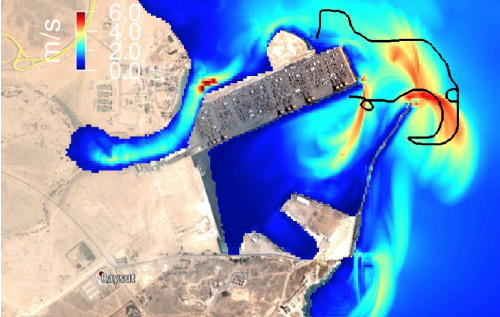
Maersk Mandraki breaks moorings during the 2004 Sumatra Tsunami. The 285-m container ship was pulled out of the Port of Salalah, Oman, drifted around the breakwater, and nearly struck the breakwater on the ocean side (Image courtesy of Jose Borrero).
Lynett, P.J., K. Gately, R. Wilson, L. Montoya, D. Arcas, B. Aytore, Y. Bai, J.D. Bricker, M.J. Castro, K.F. Cheung, C.G. David, G.G. Doğan, C. Escalante, J.M. González-Vida, S.T. Grilli, T.W. Heitmann, J.J. Horrillo, U. Kânoglu, R. Kian, J.T. Kirby, W. Li, J. Macías, D.J. Nicolsky, S. Ortega, A. Pampell-Manis, Y.S. Park, V. Roeber, N. Sharghivand, M. Shelby, F. Shi, B. Tehranirad, E. Tolkova, H.K. Thio, D. Velioğlu, A.C. Yalçiner, Y. Yamazaki, A. Zaytsev, and Y..J. Zhang (2017): Inter-model analysis of tsunami-induced coastal currents. Ocean Model., 114, 14–32, doi:10.1016/j.ocemod.2017.04.003.
Over the last decade, a number of tsunami events originating from distant regions of the Pacific Ocean have impacted the US West Coast. In some cases, the arrival of tsunami waves associated with these events has coincided with low tide levels, such as the 2006 Kuril Islands (Russia) and 2011 Tohoku (Japan) events. This fortunate circumstance helped minimize inundation of dry land, but also illustrated that tsunami-induced water currents can result in severe damage to harbor facilities, moored vessels, and the waterfront infrastructure, in general.
Traditionally, the validation of... more »
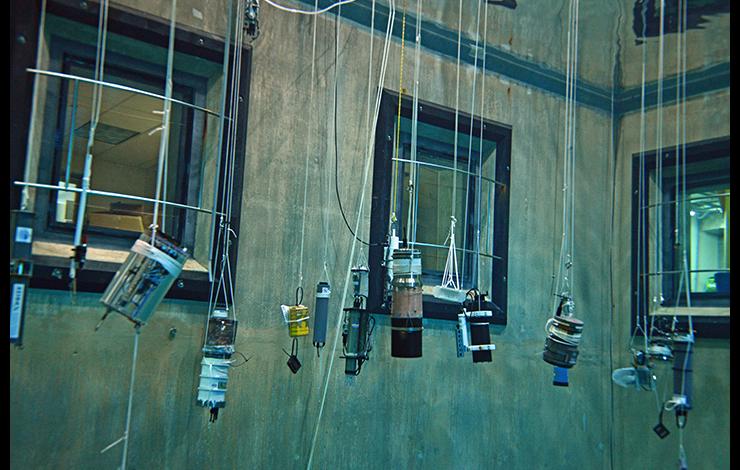
Deployment of pH sensors in the Monterey Bay Aquarium Research Institute's test pool during an early phase of the Wendy Schmidt Ocean Health XPRIZE competition.
Okazaki, R.R., A.J. Sutton, S.R. Alin, R.A. Feely, A.G. Dickson, C.L. Sabine, P.M.E. Bunje, and J.I. Virmani (2017): Evaluation of marine pH sensors under controlled and natural conditions for the Wendy Schmidt Ocean Health XPRIZE. Limnol. Oceanogr. Methods, doi:10.1002/lom3.10189.
Since the beginning of the Industrial Revolution, human activity has increased levels of carbon dioxide (CO2) released into the Earth’s atmosphere, with nearly 30% of that CO2 being absorbed by the oceans. Decades of observations have shown that the ocean’s absorption of CO2 results in a decline in seawater pH levels, thus changing the overall chemical composition of the ocean. This process, known as ocean acidification (OA), is occurring faster now than at any other time in the geologic record.
There is an ever-increasing body of documentation of OA... more »
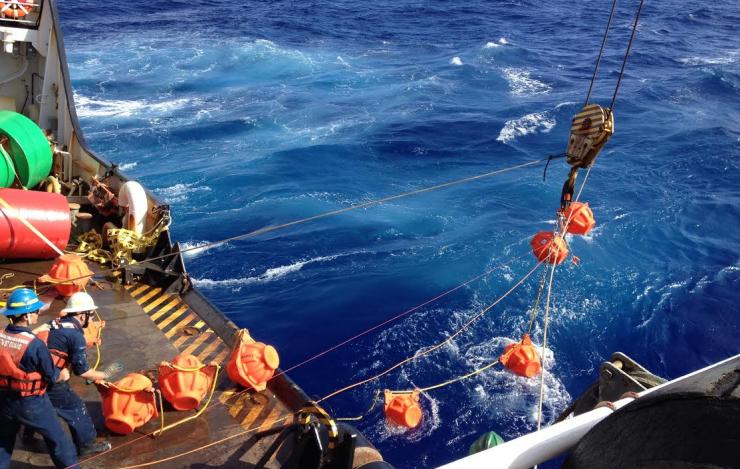
Hydrophone and mooring being deployed using crane from U.S. Coast Guard ship Sequoia. Crane block can be seen at top of image, as floats are being lowered into water.
Dziak, R.P., J.H. Haxel, H. Matsumoto, T.-K. Lau, S. Heimlich, S. Nieukirk, D.K. Mellinger, J. Osse, C. Meinig, N. Delich, and S. Stalin (2017): Ambient sound at Challenger Deep, Mariana Trench.Oceanography, 30 (2), doi:10.5670/oceanog.2017.240.
You might imagine the bottom of the ocean’s deepest point, seven miles down, to be a very quiet place. However, NOAA and partner scientists, making the first recordings from the Challenger Deep trough in the Mariana Trench in the Pacific Ocean, found something remarkably different: a wide variety of human-caused and natural sounds, including the hum of ship propellers, active sonar, earthquakes, baleen whales, and a category 4 typhoon passing near the sensor.
Human-generated noise has increased steadily over the past several decades. This project, which was funded by the NOAA Office... more »
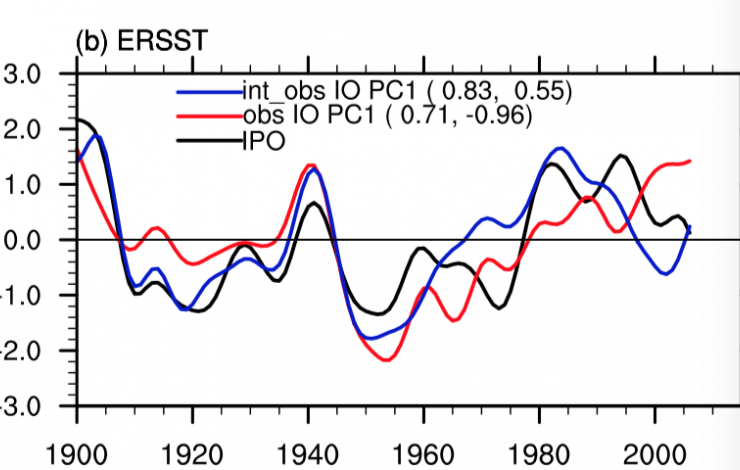
Time series of the Inter-decadal Pacific Oscillation (IPO, black lines), the decadal Indian Ocean Basin mode (IOB, red lines), and internal component of the decadal IOB mode with external forcing (obtained from ensemble mean of three all forcing runs based on CESM1.2) removed (blue lines) from ERSST. All the time series are standardized. The correlation coefficients with the IPO during 1900–2012 and 1985–2012, respectively, are shown in parentheses.
Dong, L., and M.J. McPhaden (2017): Why has the relationship between Indian and Pacific Ocean decadal variability changed in recent decades? J. Climate, 30(6), 1971–1983, doi: 10.1175/JCLI-D-16-0313.1.
Lu Dong and Michael McPhaden's recently published paper in the Journal of Climate is featured as a Research Highlight by Nature Climate Change on April 5, 2017. The paper analyzes why the relationship between the decadal Indian Ocean Basin (IOB) mode and Interdecadal Pacific Oscillation (IPO) has changed in recent decades. “Historically, patterns of decadal sea-surface temperature (SST) variability in the Indian and Pacific Oceans... more »
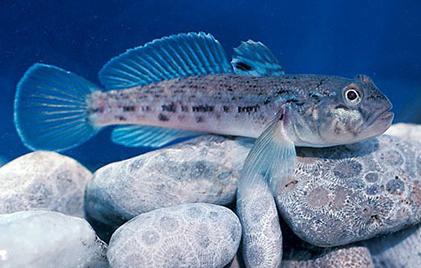
The Eurasian Round Goby Neogobius melanostomus. Photo credit: Dr. David Jude
Snyder, M.R., and C.A. Stepien (2017): Genetic patterns across an invasion's history: A test of change vs. stasis for the Eurasian round goby in North America. Mol. Ecol., 26, 1075–1090. doi:10.1111/mec.13997.
Invasive species are one of the world’s most serious environmental problems, ranking as the second most serious cause to biodiversity declines (next to habitat loss). Key U.S. aquatic systems—including the Great Lakes, San Francisco Bay, and Chesapeake Bay—have been subjected to ongoing onslaught by invasive species that are accidentally introduced from foreign ports via shipping. Several of these cause severe industrial fouling, alter ecosystem structure and functions, and change food web relationships, resulting in significant economic loss.
From the standpoint of the invasive... more »


